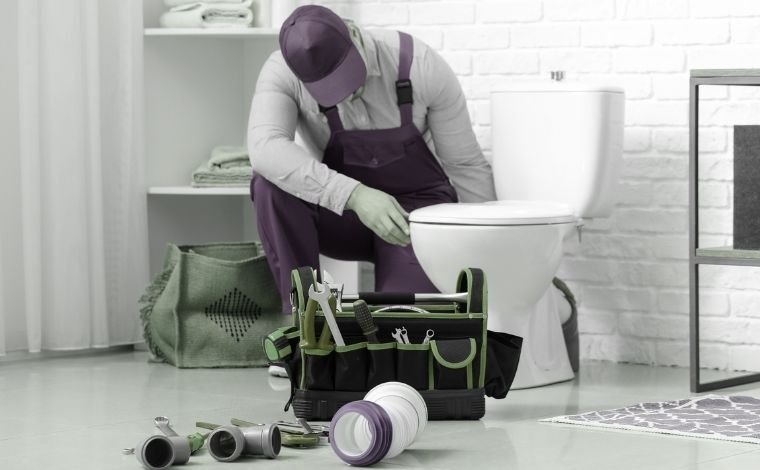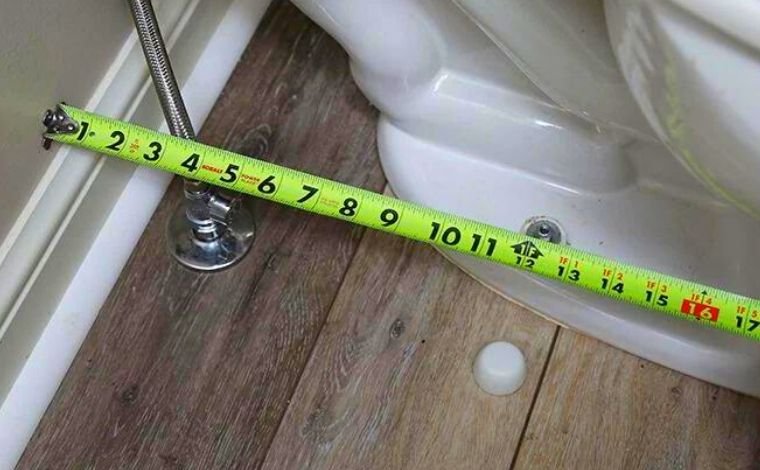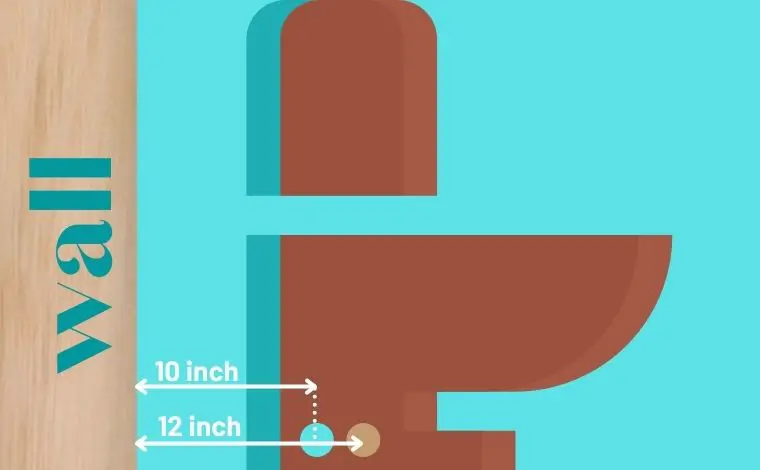Did you get bored with your old-designed restroom and want to change the style? Then I think you also know about the measurement of the toilet. Because the majority of older toilets are made with a 10-inch toilet, almost every toilet is 12 inches. Before buying a new one, you need to learn that you can install it 12 inches in place of 10 inches. It’s a critical measurement. If you think you can do it yourself, you need to learn about this in every detail. So I will try to give you a glance at this measurement, what type of problem you could face, and the solution.
What does rough-in mean for toilets?
If you are new to this site, I know rough-in is a new word to you. But this is fundamental knowledge about any sanitary side. Rough-in is a measurement and standard of the toilet. You need to measure the distance between the bathroom and the wall behind it, the drainpipe center measurement, the bolts that hold the toilet to the floor, etc. And this is mainly called rough-in of the bathroom. When you try to change your old one to a new one, you need to learn every parameter.
| Rough-in Comparison | 10-inch | 12-inch |
| Convertible: | Yes | No |
| Water consumption: | Around 2 GPF | 1.28 GPF |
| Ideal for: | Compact bathrooms | Large Bathrooms |
| WaterSense: | No | Yes |
| Compatibility: | Older toilets | Contemporary toilets |
| Durability: | Less durable | More durable |
| Clogging issue: | Common | Rare |
| Pricing factor: | Expensive | Affordable |
How to determine the rough-in?
To install a new toilet for your washroom, you need to know some parameters about both your bathroom and toilet. First, regarding the water tank height, you need to measure the size to make sure the new one can still fit in this place. You need to take the length from the floor to the top of the water tank.
Then you need to learn about the depth of the toilet. It’s imperative if you want to exchange your 10-inch bathroom for 12 inches. The primary measurement of depth is from the front side edge of the toilet bowl to the backside of the water tank length. You can install your old version if you have no problem with this length. But if you want to upgrade it a little bit, you need to choose the shallower replacement.
Now we get back to our main concentration, the measurement of your rough-in. This measurement is the span between the centers of the drainpipe to the wall behind the toilet. So you can think about how to measure the drainage pipe’s center. Don’t worry, it also has a visible solution. First, measure from the wall behind the toilet, then the middle of the bolt caps holding your bathroom with the ground. Suppose you see a four-bolt action from the wall to the rear set one. And all your measurement is done, and you are set to buy a new toilet for your new washroom.
Details about the 10-inch rough-in toilet
There are two types of rough you can find after measuring it. The eldest one is 10 inches. Now you think, what is this 10 inches irregular in? The distance between the wall behind the toilet and the center of the drainpipe is 10 inches. These are very common in old homes, so you can also find this when you want to renovate your house. But now, many people also love this type of toilet because there is still an advantage to this 10 inches toilet. 
Advantages
- These types of toilets are a space saver. So if you want to save some space in your bathroom,10 inches are the best for you,
- If your restroom is small, this toilet can easily fit there.
- You can easily interchange your 10 inches toilet with a 12-inch. That means you can install your 12 inches toilet into the older toilet place.
- It is an excellent choice for kids.
Setbacks
But there are also some difficulties you can face. Because nothing is perfect, before installing a 10 inches toilet, I think you also need to learn about this:
- It’s more expensive than 12 inches because this toilet is not regularly used.
- It is more prone, so it is easily clogged.
- You get limited features to use,
Know about 12inch rough-in toilet
Now tell you about the most commonly used rough in now. This is 12 inches rough-in—this toilet is designed for the modern bathroom. There are 12 inches from the wall behind the water tank to the center of the waste pipe. This is the standard type of toilet nowadays. And there are many features and designs you can find in the market.
Pros
There are much more advantages you see in this toilet, like:
- Most common in the market,
- Not easily clogged,
- The flush power system is upgraded and powerful
- Suitable for the child to adult.
- Variation in features and design,
- No humidity problem.
Cons
These are the advantages you find in this toilet. Most of the exciting part of this type of toilet is you find a little bit of a problem facing using it. Like:
- It’s not convertible into 10 inches,
- It needs a little extra space than the old toilet rough-in.
Comparison between 10 and 12 inches rough-in toilets
There is some difference you find between these two types of toilets. Before getting a new one for your new restroom; otherwise, you choose the wrong one, and I don’t think you should blame me for that.
- Estimation: I know you can easily differentiate between these two toilets. There is only 2 inches difference between this rough-in. But, believes me, it matters. You can convert 10 to 12 but not interchange it again. And the difference between walls and waste pipes also helps from humiliation.
- Clog: 12 inches toilet is famous for its not easily clogged function. You can easily find 10 inches at any old home; they are straightforward to clog. Rather than 12 inches are easy to use and do not quickly stop.
- Humidity Problem: If you live in a humid area, don’t pick the 10 inches toilet. Because it has prone, and it damps quickly and gets mold there. This is not only dirty but also unhealthy. From this side, 12 inches are perfect, and you don’t face such a problem there.
- Space: 10 inches rough in need of less space than 12 inches. So if you have little space in your restroom, you can easily adjust a 10 inches toilet there.

- Water usage: 10 inches rough-in are old versions, and it needs 1.6-2 gallons of water per flush. But with the help of modern science, it is just lower in usage. Now almost all toilets use 1.28 gallons of water. That means you save 0.32 gallons of water per flush, and yes, it is an excellent contribution to your environment. so 12 inches are also saving water.
How to replace a 10-inch rough-in with a 12-inch rough-in?
You can easily upgrade your bathroom in renovation time. A 10-inch rough is easily convertible. It would help if you made 2 inches extra from the rare drop passage and outlet opening side. First, measure some extra inches from the drain opener. Then use an offset flange to get the right size rough-in. It would help if you had the wax ring to seal the toilet tightly. Then cut the water line to install the new bathroom. Then flush all the water out of the tank. Use a cloth or sponge to dry out the bowl. Then, carefully detach the toilet, remove the old wax ring, and clear the section.
Now attach the new flange into there. Then again, add a wax ring and seal it tightly. Use bolts to secure the toilet with the ground when it is done. When you are done, link the bathroom with the waterline and check the water tank is attached adequately. Otherwise, you end up with a runny water tank. And you are done with your new 12 inches toilet now.
Final thought
There are four types of rough-in toilets: 8, 10, 12, and 14 inches. But most commonly used are 10 and 12 inches. So if you read this, I think you know which is perfect. If your washroom has a small space, 10 inches rough is excellent. But there are some faults you face when using it. The most common is toilet clogging. So maintenance is more complicated than 12 inches. If you have enough space in your washroom, 12 inches is best for you.
We are really lucky to have a hard-working, multi-skilled plumber on our team. Collin D. Gallegos, a professional plumber who has worked with us since 2012, is an expert in vent, septic, and drainage systems. He is a Certified Master Plumber and has worked on various commercial plumbing projects. He usually helps our readers resolve plumbing and pipe-related issues with a proper DIY troubleshooting and repair guide.
